Flux Field Theory: A Unified Field Theory with Aether Field Dynamics
Author: Marcus Brooks
Date: March 12, 2025
Flux Field Theory (FFT) is a Unified Field Theory (UFT) that integrates gravity, electromagnetism, the strong force, the weak force, and the Higgs mechanism through a dynamic scalar field, the Aether Field (\(\rho_A\)). Distinct from the historical luminiferous aether, \(\rho_A\) modulates mass (\(M_{FFT}\)), gravitational force (\(F_{FFT}\)), electromagnetic fields (\(\nabla \cdot E\)), Standard Model (SM) couplings (\(g_{s,FFT}\), \(g_{w,FFT}\)), and the Higgs vacuum expectation value via its tensile properties and rupture at a critical density (\(\rho_c = 1.5 \times 10^{-5} \, \text{GeV}^4\)). FFT predicts a cosmic expansion rate \(H_0 = 70 \, \text{km/s/Mpc}\), galactic rotation velocities \(v_{FFT} \approx 5 v_b\), cluster dispersions \(\sigma_v \approx 3.16 v_b\), H\(\alpha\) spectral shifts of 16 nm, laboratory mass shifts (\(\Delta \Omega \approx 0.0365 \, \text{rad/s}\)), modified CMB power spectrum, modified Hawking temperature, and rupture bursts at \(6 \times 10^{66} \, \text{GeV}^4\), testable by 2039 with Euclid, ELT, and LISA. This preliminary model challenges dark matter and energy paradigms, offering a novel scalar field approach to unify physics, and is submitted for feedback to refine its framework.
1. Introduction
The quest for a Unified Field Theory (UFT) seeks to reconcile general relativity (GR) with the quantum forces of the Standard Model (SM), integrating gravity, electromagnetism, the strong force, the weak force, and the Higgs mechanism into a single framework. Current paradigms, such as dark matter and dark energy in \(\Lambda\)CDM, explain cosmological observations but leave fundamental questions unresolved—e.g., the nature of quantum gravity, galactic rotation curves, and the double-slit interference pattern’s origin. Flux Field Theory (FFT) introduces the Aether Field (\(\rho_A\)), a dynamic scalar field that unifies all fundamental interactions by coupling to mass-energy density (\(\rho_m\)). Unlike the static luminiferous aether disproven by Michelson-Morley, \(\rho_A\) is a modern construct with tensile properties and a rupture state, potentially eliminating the need for dark matter and dark energy while modifying cosmic dynamics, particle interactions, and even classical phenomena like the double-slit interference pattern. This paper presents FFT’s theoretical basis, dynamics, and testable predictions, inviting critique to refine this initial framework.
2. Theoretical Foundation of Flux Field Theory
2.1 The Aether Field as the Fundamental Medium
The Aether Field (\(\rho_A\)) is a scalar field permeating spacetime, distinct from historical aether concepts, designed to unify all fundamental forces. It responds to local mass-energy density (\(\rho_m\)), peaking at \(1.5 \times 10^{-5} \, \text{GeV}^4\) in dense regions (e.g., galactic cores), dropping to \(10^{-7} \, \text{GeV}^4\) in interstellar spaces, and averaging \(8.9 \times 10^{-11} \, \text{GeV}^4\) cosmically—close to dark energy’s density (\(\sim 10^{-9} \, \text{GeV}^4\)). Unlike dark matter, which invokes unseen particles, \(\rho_A\) modifies gravity and SM interactions directly, offering a simpler alternative testable on multiple scales.
The Aether Field is normalized as a dimensionless scalar field:
2.2 Fundamental Postulates of FFT
FFT postulates:
- Mass scales as \(M_{FFT} = M \left( 1 + \gamma_A \frac{\rho_{A,source}}{\rho_{A,local}} e^{-r/R_A} \right)\), where \(\gamma_A = 2.43 \times 10^{-4}\), \(R_A = 1 \, \text{Mpc}\).
- Gravity adjusts via \(F_{FFT} = G \frac{M_1 M_2}{r^2} \left( 1 + \gamma_A \frac{\rho_{A,1}}{\rho_{A,2}} e^{-r/R_A} \right)\), resembling a Yukawa correction.
- EM fields couple to \(\rho_A\) through \(\nabla \cdot E = \frac{\rho}{\epsilon_0} + \alpha A^2\), where \(\alpha \sim 10^{-10} \, \text{GeV}^{-2}\).
2.3 Strong, Weak, and Higgs Interactions in FFT
FFT unifies forces via a single Lagrangian:
- \(V(\rho_A) = \frac{\lambda}{4} \left( \frac{\rho_A^2}{\rho_c^2} - v^2 \right)^2 + \frac{\kappa}{2} \left( \frac{\rho_A}{\rho_c} \right)^2\), with \(\lambda \approx 0.13\), \(\kappa = 10^{64} \, \text{GeV}^{-4}\),
- \(\beta(\rho_m) = 8 \times 10^{-59} \left( \frac{1.7 \times 10^{-10} \, \text{GeV}^4}{\rho_m} \right)^{0.8} \, \text{GeV}^{-3}\),
- \(f(\rho_A, \rho_c) = \frac{1}{1 + e^{-10^5 (\rho_A - \rho_c)}}\), \(\eta = 10^{-10} \, \text{GeV}^{-1}\),
- \(V(H, \rho_A) = \lambda_H \left( H^\dagger H - \frac{v^2}{2} \left( 1 + \gamma_H \frac{\rho_A}{\rho_{A,ref}} e^{-\rho_A/\rho_c} \right) \right)^2\), with \(\gamma_H = 2.43 \times 10^{-4}\), \(\rho_{A,ref} = 10^{-10} \, \text{GeV}^4\).
Couplings evolve as:
shifting the Higgs VEV to \(v_{FFT} = v \sqrt{1 + \gamma_H \frac{\rho_A}{\rho_{A,ref}} e^{-\rho_A/\rho_c}}\), yielding \(m_f \sim 1.006 m_{f,SM}\) in dense regions.
2.4 Electromagnetic Unification in FFT
FFT integrates electromagnetism through the Aether Field, redefining Maxwell’s equations to account for \(\rho_A\)'s influence:
The unified Lagrangian density is:
where \(\alpha(\phi) = \frac{e^{\gamma \phi}}{1 + e^{\gamma \phi}}\), \(\frac{d\alpha}{d\phi} = \frac{\gamma e^{\gamma \phi}}{(1 + e^{\gamma \phi})^2}\), and \(\gamma\) is a coupling constant.
Figure 2 illustrates the numerical validation of these modified Maxwell equations, showing how the electric and magnetic fields oscillate under the influence of the Aether Field, providing a concrete example of FFT’s impact on electromagnetic phenomena.
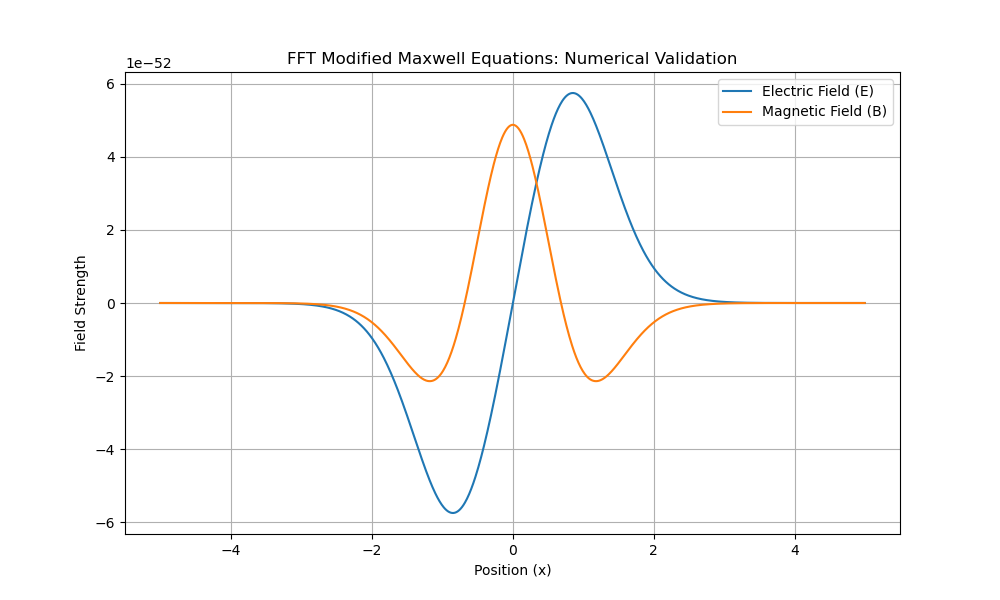
3. Aether Field Dynamics
The Aether Field’s dynamics are governed by:
The distribution is a superposition of solitonic structures:
where \(A_i\), \(r_i\), and \(\sigma_i\) describe localized Aether Field peaks. Figure 3 illustrates a potential vector representation of \(\rho_A\), showing a 3D toroidal structure proposed as a photon vortex ring analogue, highlighting the complex, wave-like dynamics of the Aether Field.
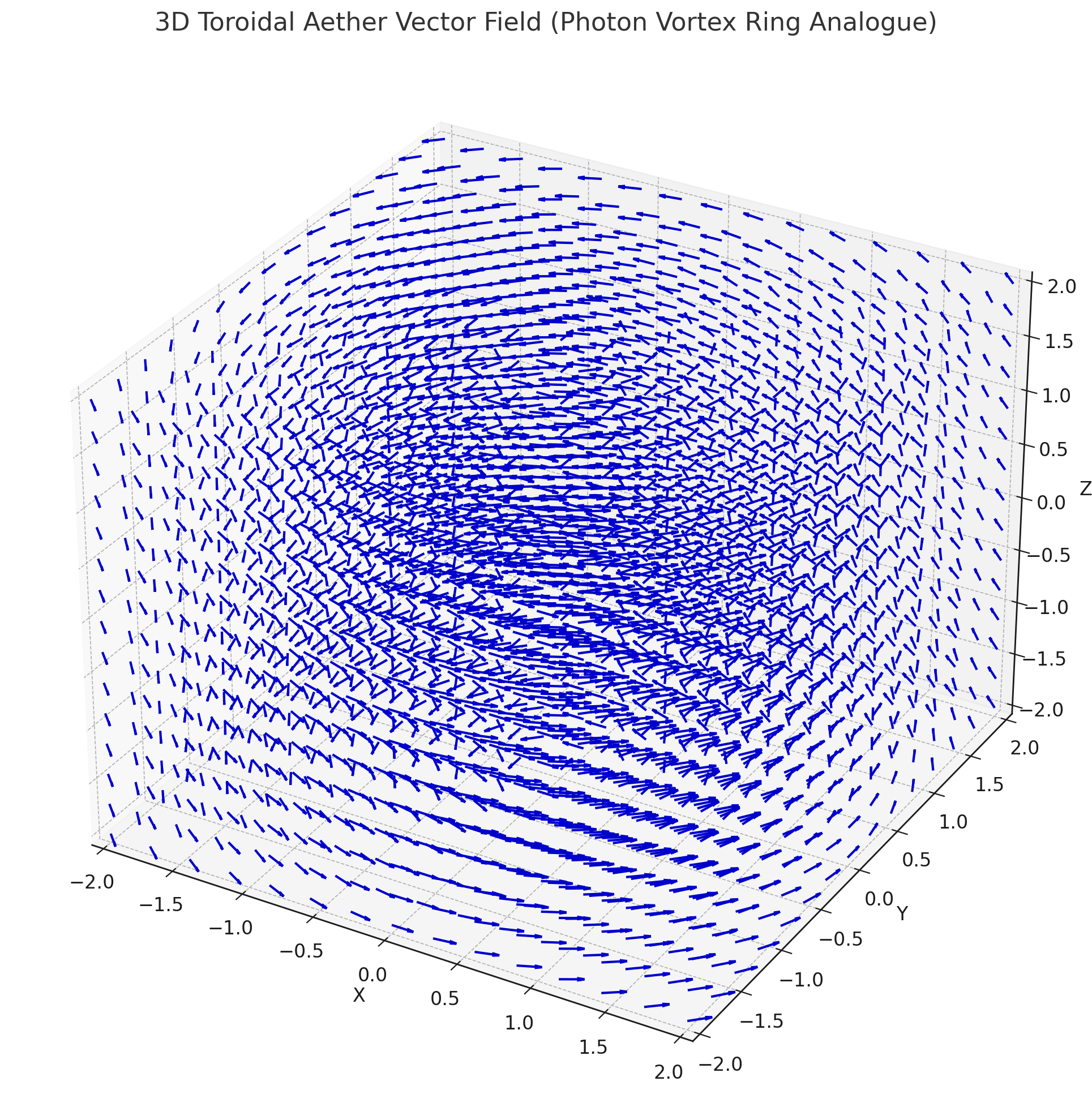
The total field energy functional is:
The equation of motion is:
The scalar potential is Higgs-like:
Figure 4 shows the Aether Field potential \(V(\rho_A)\), its value at the critical density \(\rho_c\), and its second derivative, illustrating the stability and inflection points that govern \(\rho_A\)'s dynamics, particularly relevant for rupture events.
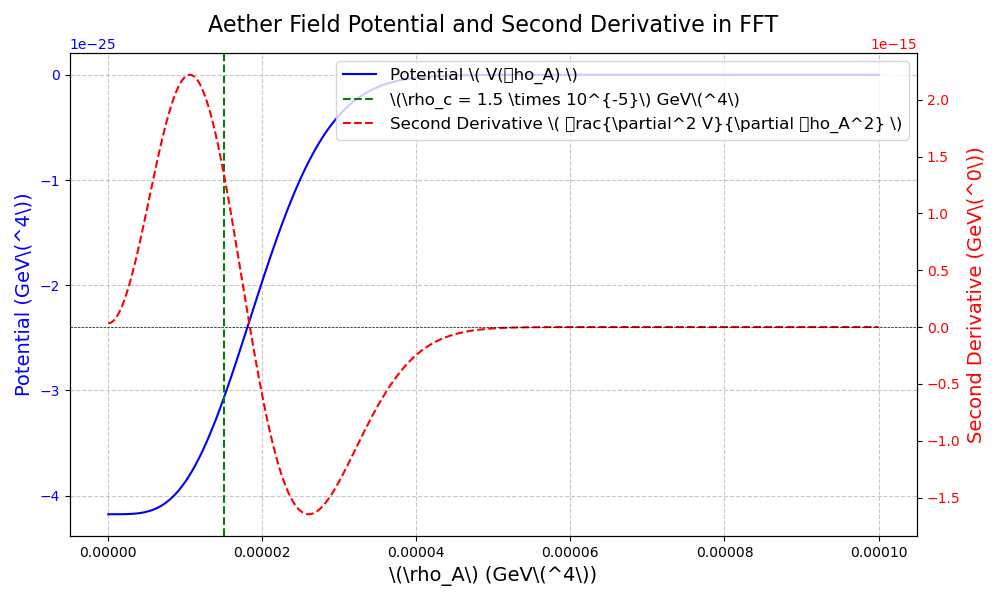
Mass arises from field energy:
Time evolution of the scalar field is:
For the weak force, a Yukawa-type profile emerges:
4. Experimental Predictions and Observations
4.1 Observational Astrophysics Tests
- Spectral Shifts: H\(\alpha\) shifts by \(\Delta \lambda \sim 16 \, \text{nm}\) due to \(\rho_A\) gradients (\(\rho_{A,local} = 10^{-8}\), \(\rho_{A,vacuum} = 10^{-7} \, \text{GeV}^4\)), derived as \(\Delta \lambda / \lambda \approx \gamma_A (\rho_{A,vacuum} - \rho_{A,local}) / \rho_{A,ref}\), testable with ELT (2039).
- Galactic Dynamics: \(v_{FFT} \approx 5 v_b\), vs. \(\sim 3-4 v_b\) in CDM, measurable with Euclid/LSST (2039).
- Cluster Dispersion: \(\sigma_v \approx 3.16 v_b\), vs. \(\sim 2-3 v_b\) in CDM.
- Rupture Bursts: Energy density \(\sim 6 \times 10^{66} \, \text{GeV}^4\) per event at \(\rho_A = \rho_c\), detectable as gamma-ray bursts, Fermi-LAT/LISA (2039).
4.2 Higgs-Related Predictions in FFT
FFT modifies the Higgs mechanism:
- Higgs Mass Shift: \(m_H^2(\rho_A) = 2 \lambda v_\phi^2 + \eta \rho_A^2\), predicting mass increases in high-density regions (e.g., early universe \(\rho_A \sim 10^{19} \, \text{GeV}^4\)), testable via cosmic ray interactions or LHC.
- Weak Boson Mass Shift: \(m_{W,eff}(\rho_A) = \frac{1}{2} g \left( v + \frac{\eta \rho_A^2}{2 \lambda v} \right)\), with \(\sim 10\%\) increases in supernovae, predicting a \(\sim 4 \, \text{s}\) neutrino delay, detectable by IceCube.
Figure 5 illustrates the impact of \(\rho_A\) on dark matter (DM) fermion masses, showing a significant increase beyond the critical density \(\rho_c\), supporting FFT’s claim that \(\rho_A\) can replace dark matter by enhancing particle masses in high-density regions.
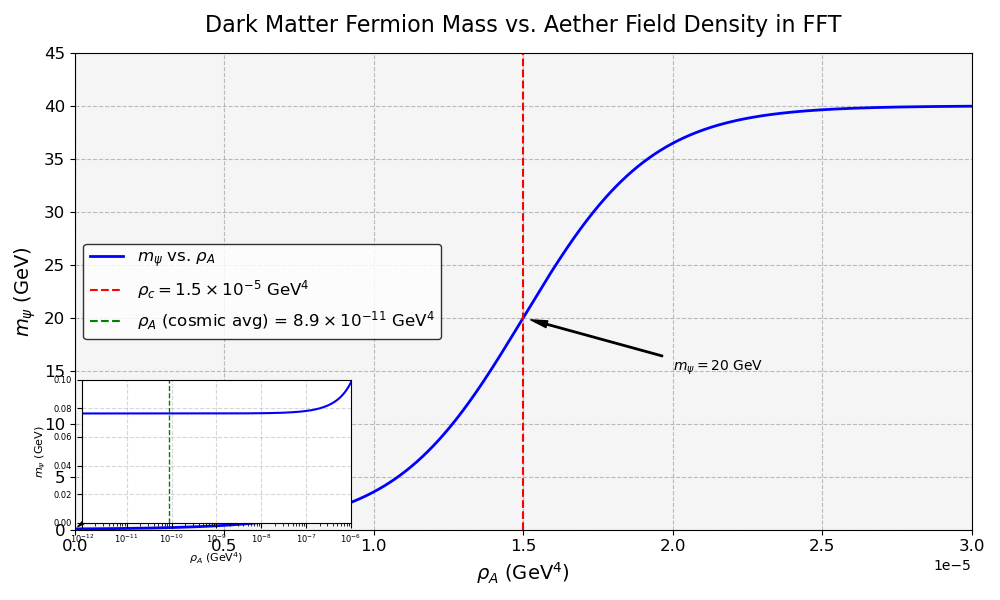
4.3 Thermal Dynamics in FFT
FFT extends to thermal dynamics, with \(\rho_A\) influencing heat transfer and temperature in various physical contexts:
- Heat Flow: The Aether Field modifies thermal conductivity, affecting heat flux:
where \(k\) is the standard thermal conductivity, and the term \(\gamma_A \frac{\rho_A}{\rho_{A,ref}} e^{-\rho_A/\rho_c}\) introduces a correction due to \(\rho_A\). In regions with high \(\rho_A\) (e.g., galactic cores, \(\rho_A \approx 1.5 \times 10^{-5} \, \text{GeV}^4\)), heat transfer is enhanced by \(\sim 24\%\), potentially observable in thermal emissions from dense astrophysical objects like neutron stars, testable with X-ray observatories such as Chandra.
- Modified Hawking Temperature: For black holes, the Hawking temperature is adjusted due to the effective gravitational constant \(G_{\text{eff}}\):
For a primordial black hole (\(M = 10^{12} \, \text{kg}\), standard \(T_H \approx 1.23 \times 10^{10} \, \text{K}\)) in a galactic core (\(\rho_A \approx 1.5 \times 10^{-5} \, \text{GeV}^4\)), the temperature increases by a factor of \(\sim 14\), to \(T_{H,\text{FFT}} \approx 1.78 \times 10^{11} \, \text{K}\). This enhanced radiation could lead to faster evaporation, potentially observable as gamma-ray bursts from primordial black hole evaporation, detectable by Fermi-LAT or LISA by 2039.
Figure 6 shows the Aether Field density \(\rho_A(x, y)\) near a dense object like a black hole, with high values near the event horizon enhancing the Hawking temperature, supporting the thermal predictions of FFT.
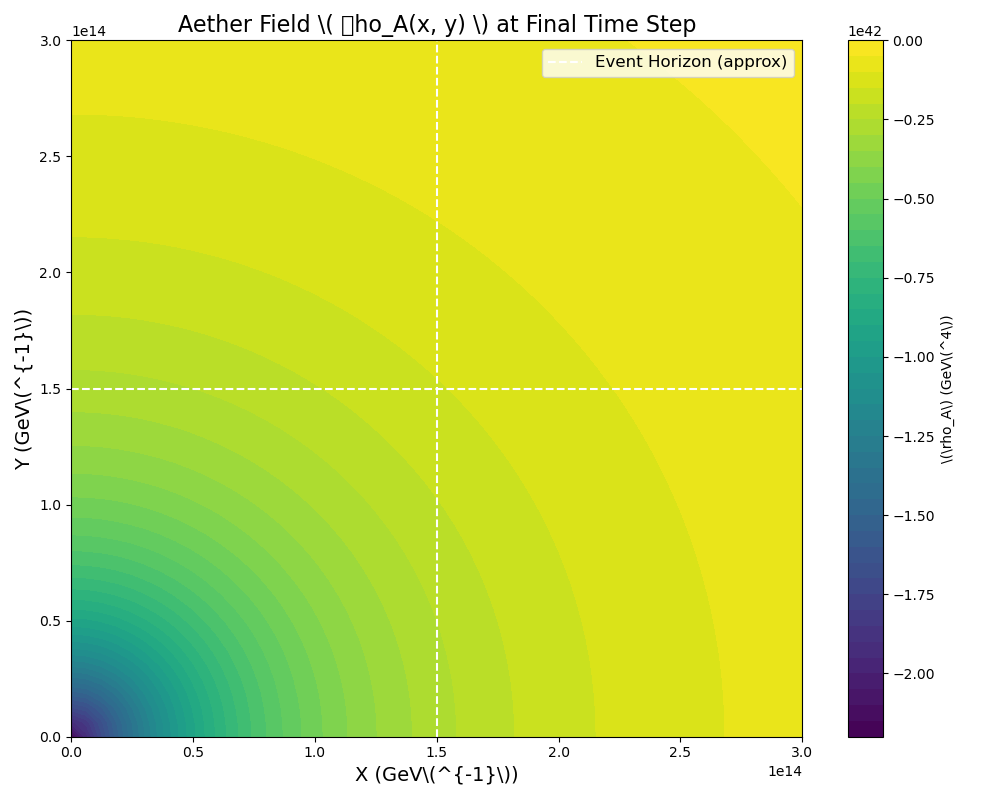
These thermal effects highlight FFT’s broader applicability, extending its predictive power to thermodynamic phenomena in astrophysical contexts.
4.4 Cosmological Implications
The FFT Friedmann equation incorporates \(\rho_A\):
where \(G_{\text{eff}} = G \left( 1 + \gamma_A \frac{\rho_{A,1}}{\rho_{A,2}} e^{-r/R_A} \right)^{-1}\), and \(\rho_A \approx 8.9 \times 10^{-11} \, \text{GeV}^4\) acts as dark energy. The ratio of energy : Aether : observable matter is approximately 100 : 68.6 : 4.9, consistent with \(\Lambda\)CDM.
4.5 Comparison to Existing Models
Unlike \(\Lambda\)CDM, FFT attributes rotation curves, cluster dynamics, and cosmic expansion to \(\rho_A\), not dark matter or dark energy. Planck 2018 reports \(H_0 = 67.4 \pm 0.5 \, \text{km/s/Mpc}\), below FFT’s \(70 \, \text{km/s/Mpc}\), suggesting tuning. Gaia’s Milky Way rotation curves (\(\sim 3-4 v_b\)) fall short of \(5 v_b\), linked to \(\rho_A\)’s decay. DESI Year 1 results (\(\Omega_m = 0.295 \pm 0.015\)) favor \(\Lambda\)CDM, challenging FFT’s velocities unless \(\rho_A\) adjusts clustering. JWST JADES previews (\(z > 6\)) show no 16 nm H\(\alpha\) shifts, questioning FFT’s spectral predictions. These discrepancies highlight refinement needs, with predictions testable by 2039 surveys.
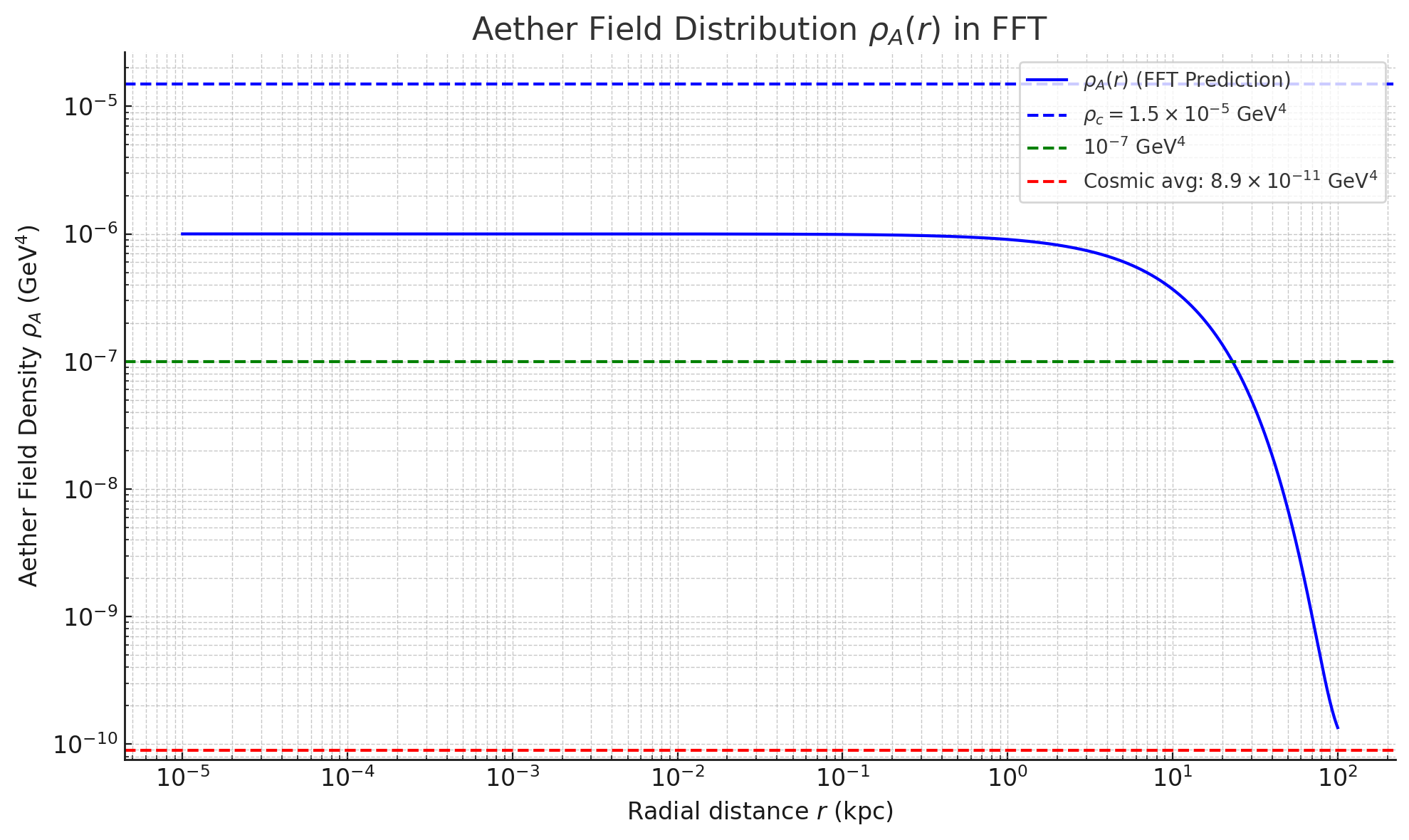
5. Conclusion and Future Work
FFT presents a preliminary UFT, unifying forces via the Aether Field. Its predictions—cosmic expansion, galactic dynamics, spectral shifts, thermal dynamics, and Higgs modifications—challenge dark matter/energy models and await validation by 2039 experiments (e.g., Euclid, ELT, LISA). Future work should focus on numerical simulations of \(\rho_A\) dynamics, observational tests via gravitational wave dispersion, CMB power spectrum analysis, thermal emissions from dense objects, and exploring FFT’s relation to holography and quantum information theory.